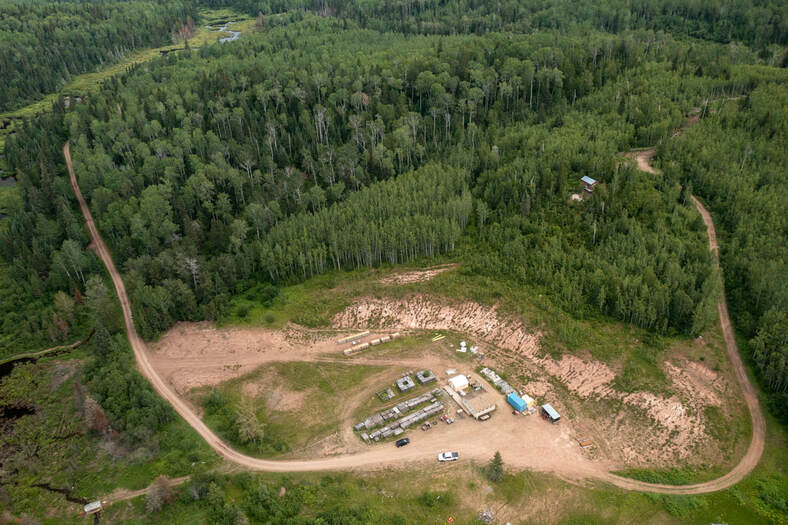Thunder Gold drills 941 g/t gold over 1.5 metres at Tower Mountain, Ontario

Thunder Gold Corp. [TGOL-TSXV; TNMTS-OTC; Z25-FSE], formerly White Metal Resources Corp., reported results from the first three holes of the 2023 phase 1 drill campaign currently under way at the 100%-optioned Tower Mountain gold property, located 50 km west of Thunder Bay, northern Ontario, in the Shebandowan greenstone belt.
Highlights: TM23-137 intersected 941.0 g/t gold over 1.50 metres with multiple sites of visible gold observed at a depth of 126.7 metres downhole within a broader interval averaging 1.81 g/t (CAPPED at 30.0 g.t Au) over 41.0 metres.
TM23-137 also intersected 0.77 g/t gold over 23.0 metres and 0.83 g/t gold over 58.0 metres. TM23-138 intersected 1.26 g/t gold over 17.5 metres and 0.71 g/t over 119.0 metres. TM23-136 intersected 0.68 g/t gold over 12.0 metres and 0.75 g/t gold over 11.7 metres;
The three holes establish 200 metres of mineralized strike length along a previously untested N-S corridor. All three holes terminate in mineralization. This new zone, identified by geophysics, offers over 1000 metres of untested strike length and remains open in all directions.
Wes Hanson PGeo, CEO, noted: “Any time you come out of the gate with visible gold and the highest grade ever reported from a property with over 25,000 historical core samples, you’ve got to be excited. The rather impressive 941.0 g/t gold reports over a 1.5-metre interval and is driven by multiple sites of visible gold occurring within a centimetre scale quartz-carbonate-tourmaline vein intersected at a depth of 126.7 metres downhole. The vein occurs within a 41.0-metre interval averaging 1.81 g/t gold (interval capped at 30.0 g/t Au). The cap ONLY affects the 941.0 g/t interval containing the observed visible gold, all remaining assays within the 41.0-metre interval range from 0.09 to 5.80 g/t gold.
“The results from the first three holes clearly demonstrate the validity of our exploration model and the validity of Induced Polarization as an efficient, accurate, exploration vector. All three holes intersected widespread, low-tenor (+0.10 g/t Au) gold mineralization from surface to the end of each hole as anticipated. Holes TM23-137 and 138 intersected elevated gold grades (+0.30 g/t) over intervals ranging from 12 metres to one 119 metres, returning weight averaged grades ranging from 0.68 to 1.81 g/t gold. The frequency of intervals greater than 0.30 g/t gold is double that of the historical data population, as predicted.
“In simple terms, these holes, targeting an untested IP anomaly along a 1,000-metre strike length, are returning high gold grades, more frequently than the historical data set. It is important to note that the average reported grades are consistent with the average operating and reserve grades reported at all large-tonnage, low-grade open pit mines and development projects in Canada today.
“The company is also pleased to report that inversion of the recently completed IP survey is nearly complete. Preliminary analysis has identified new targets to the east and south of the Tower Mountain Intrusive Complex with a similar response to the known areas of mineralization. The preliminary interpretation has also isolated strong north-south lineaments, the longest and strongest of which is the focus of the phase one drill campaign currently 50% completed. This lineament extends for over 1,000 metres of untested strike length. With only 20% of this untested area assayed, we are are already seeing strong evidence supporting our conceptual exploration model and we continue to demonstrate the validity of a cheap, cost-effective primary exploration vector. We are also beginning to piece together a working geological model which will guide future exploration. We see a unique opportunity at Tower Mountain: a path towards a large-tonnage, low-grade gold discovery located in a premium mining jurisdiction, 50 km from a major population centre, with year-round paved highway access, significant exploration upside, viable predictive tools and low exploration costs. Our goal is to rapidly demonstrate the potential for a large-tonnage, low-grade gold discovery.”
